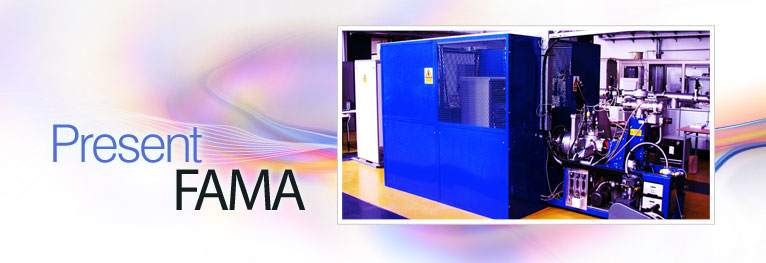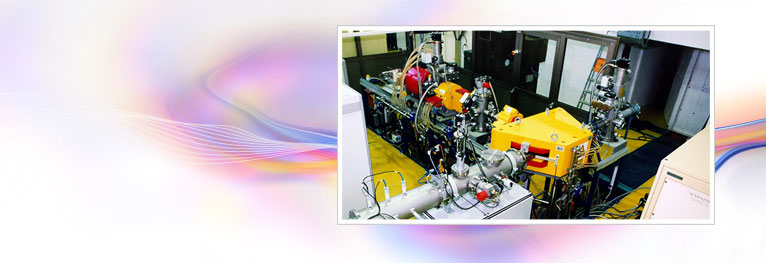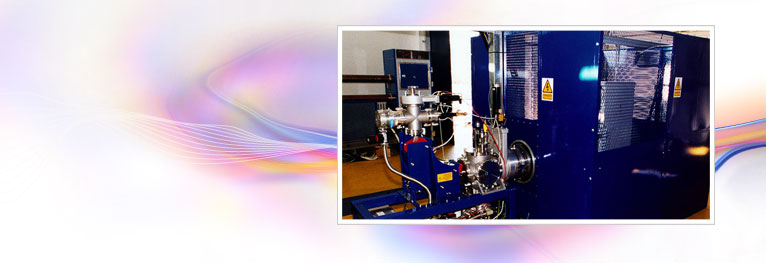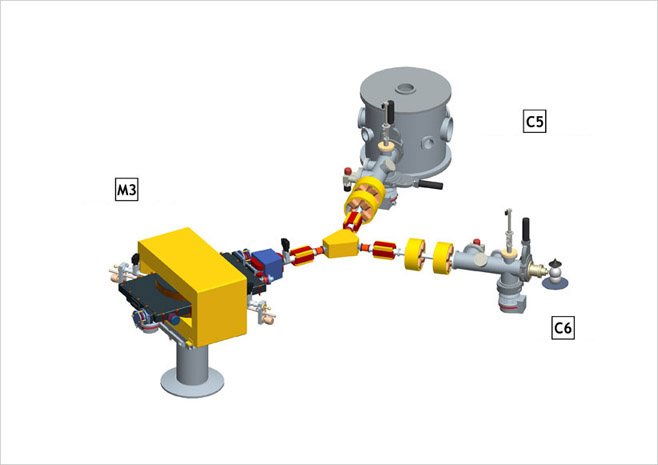 |
 |
 |
| Present FAMA |
| FAMA is the low energy part of TAI. It represents a user facility for basic and applied research in the field of modification and analysis of materials with ion beams (FАcility for Modification and Analysis of materials with ion beams). FAMA is also the largest part of the scientific infrastructure in Serbia. It is located in the Laboratory of Physics of the Vinča Institute. The present FAMA comprises two machines and two experimental channels. The machines are a plasma source of multiply charged heavy ions (M1) and a plasma source of positive or negative light ions (M2). The experimental channels are the channel for analysis of ion beams (C1) and the channel for surface modification of materials (C2). They are connected to the M1 machine. |
 |
 |
| The M2 machine was commissioned in July 1997, as the light ion source of the VINCY Cyclotron. From January 2008, it has been used for surface modification of materials with light ion beams. The M1 machine and C2 channel were commissioned in May 1998. Since then, they have been used jointly for surface modification of materials with heavy ion beams. Various metallic, semiconducting, carbon, polymer and ceramic materials have been bombarded with heavy ions obtained from various gaseous and solid substances. The interaction chamber of the C2 channel includes the equipment for applying the technique of ion beam assisted deposition (IBAD), which can be combined with the technique of ion bombardment. The C1 channel was commissioned in December 2008. The direct costs of construction of FAMA were EUR 3.80 million (see the part of supplement 3 on the existing equipment). From that amount EUR 2.77 million were spent for the equipment and EUR 1.03 million for the buildings. |
 |
 |
| Program of use of FAMA is focused on new materials and nanotechnologies. It is currently realized by 12 user groups from Serbia and one from Russia. The corresponding topics, leaders of the user groups and institutions are given in Table 1. The research mentioned in this table is financed through the current projects of the Ministry of Science and Technological Development of Serbia from the Program of Basic Research, whose realization will end in December 2010, and from the budget of the Joint Institute. |
 |
| No. |
Topic |
Leader of user group |
Institution |
| 1 |
Diagnostics of highly charged ions from electron cyclotron resonance plasmas |
A. Dobrosavljević |
Laboratory of Physics,
Vinča Institute |
| 2 |
Nanostructuring metal/silicon bilayers induced by ion
irradiation |
N. Bibić |
Laboratory of Atomic Physics, Vinča Institute |
| 3 |
Preparation of metal-polymer nanocomposite films by implantation of metal ions in polymer substrates |
V. Djoković |
Laboratory of Radiation Chemistry and Physics,
Vinča Institute |
| 4 |
Analysis of materials by ion beam thermal radiometry |
S. Galović |
Laboratory of Radiation Chemistry and Physics,
Vinča Institute |
| 5 |
Modification of metal hydrides by heavy ion irradiation |
J. Grbović Novaković |
Laboratory of Materials,
Vinča Institute |
| 6 |
Modification of ethylene-norbornene copolymer with ion
beams |
Z. Kačarević- Popović |
Laboratory of Radiation Chemistry and Physics,
Vinča Institute |
| 7 |
Designing carbon materials for electrochemical applications |
Z. Laušević |
Laboratory of Physics,
Vinča Institute |
| 8 |
Trapping hydrogen isotopes in plasma facing materials in
fusion nuclear reactors |
S. Korica |
Laboratory of Physics, Vinča Institute |
| 9 |
Heavy ion implantation in silicon crystals |
S. Petrović |
Laboratory of Physics, Vinča Institute |
| 10 |
Modification of titanium surfaces with hydroxyapatite
coatings and ion beams |
V. Mišković- Stanković |
Faculty of Technology and Metallurgy, University of Belgrade |
| 11 |
Photoacoustic investigations of ion implanted
semiconductors |
D. Todorović |
Institute for Multidisciplinary Research, Belgrade |
| 12 |
Modification of steel surfaces with superhard
nanocomposites and ion beams |
D. Kakaš |
Faculty of Technical Sciences, University of Novi Sad |
| 13 |
Nanostructuring silicon crystals with helium ion beams |
A. Skuratov |
Flerov Laboratory of Nuclear Reactions, Joint Institute |
|
|
| |
 |
| Upgrading FAMA |
In May 2008 the realization of the three-year contract with the Joint Institute on the upgrading of FAMA commenced in the Laboratory of Physics of the Vinča Institute, on the basis of the agreement of the Government of Serbia and Government of Russia on the regulation of the clearing debt of Russia to Serbia. The value of the equipment that will be delivered, which will appear as a result of the specific combining the Russian engineering and the Europen and US technologies, will be about USD 5 million.
This contract comprises (i) the refurbishment of the M1 and M2 machines and the C1 and C2 channels, (ii) the construction of the channel for ion implantation (C3) and the channel for deeper modification of materials (C4), which will be connected to the M1 and M2 machines, (iii) the construction of the small isochronous cyclotron that will deliver the proton beam of the energy of 2.5 MeV, (iv) the construction of the channel for deeper analysis of materials in vacuum (C5) and the channel for deeper analysis of materials in air (C6), which will be connected to the M3 machine, and (v) the purchasing of a scanning probe microscope. Upon the refurbishment the C1 channel will become the channel for analysis of ion beams and irradiation, and the C2 channel will be connected to the M2 machine too.
The C3 channel will enable ion implantation in single crystals in ultrahigh vacuum, and in the C4 channel one will have the additional acceleration voltage, in front of the target. In the C5 channel one will be able to investigate materials in vacuum with the Rutherford backscattering spectrometry (RBS), the proton elastic scattering (PES) spectrometry, the nuclear reaction analysis (NRA) and the proton induced X-ray emission (PIXE) spectroscopy. In the C5 channel one will be able to analyze materials in air with the PIXE spectroscopy. The scanning probe microscope will enable the applications of a series of techniques for surface analysis of materials. With a successful realization of the contract Serbia will obtain one of the most modern user facilities in the field of modification and analysis of materials with ion beams in Europe. |
 |
 |
 |
| Operation and maintenance of FAMA |
In the previous period of realization of the research projects the Ministry of Science and Technological Development of Serbia was also financing the operation and maintenance of FAMA. As a result, the user groups of FAMA, mentioned in Table 1 in part (b) of this supplement, were using FAMA according to their needs and without any financial or other compensation. Those activities were going on according to the yearly plans made in agreement with the user groups.
Our request is that the project also comprises the job of operation and maintenance of FAMA, which will enable its user groups to perform experiments in the field of new materials and nanotechnologies in the period between 2011 and 2014 as well. This request represents a necessary condition for the realization of the project.
As in the previous period, the number of collaborators of the project who will be financed for performing this job will be 16. The members of this team will also be eight collaborators of the project who will be financed for the realization of the research part of the project. The head of the team for operation and maintenance of FAMA will be Z. Laušević. The obligation of the team is to ensure that each user group perform successfully at least one experiment per year. In 2011 and 2012 the present FAMA will be used, and the total requested amount for its operation and maintenance is EUR 413,855 per year (see the part of supplement 3 on the existing equipment). In 2013 and 2014 the user groups will have the upgraded FAMA at their disposal, and the total requested amount for its operation and maintenance is EUR 492.751 per year. |
 |
The first user group mentioned in Table 1 is connected to subproject (1) of the project, the seventh and twelfth user groups are connected to subproject (3) of the project, and the eighth and ninth user groups are connected to subproject (2) of the project. The second, fourth and sixth user groups will act in the forthcoming period within project Functional, functionalized and advanced nanomaterials, the third user group will act within project Influence of size, shape and structure of nanoparticles on their properties and properties of nanocomposites, the fifth user group will act within project Synthesis, processing and characterization of nanostructural materials for applications in the fields of energy, mechanical engineering, protection of the environment and biomedicine, and the tenth user group will act within project Synthesis, development of technologies for obtaining and applications of nanostructural multifunctional materials with defined properties. All these projects should be financed in the forthcoming period by the Ministry of Science and Technological Development of Serbia. The activities of the thirteenth user group in the forthcoming period will be financed from the budget of the Joint Institute.
We are proposing to the Ministry of Science and Technological Development to form the expert body whose activities would be focused on achieving and maintaining the high quality and relevance of the research of the user groups of FAMA. It would be called the FAMA Advisory Committee, and would meet once a year to analyze the results of the experiments performed with FAMA in the previous year and report about that to the Ministry of Science and Technological Development. The members of this expert body could be the following European experts in the field of materials science: A. Kolitsch, Institut für Ionenstrahlphysik und Materialforschung, Forschungszentrum Dresden-Rossendorf, Dresden, Germany, R. Webb, Faculty of Engineering and Physical Sciences, University of Surrey, Guildford, UK, and A. Auroux, Institut de Recherches sur la Catalyse et l’Environnement de Lyon, Université Claude Bernard 1, Villeurbanne, France. |
 |
|
|